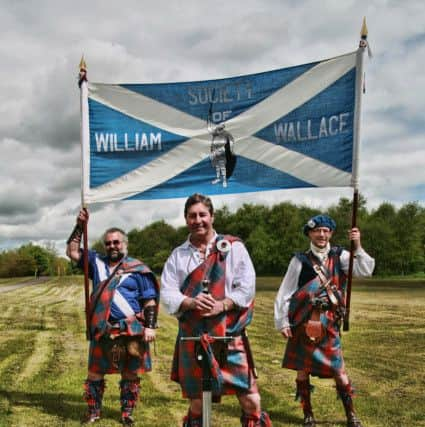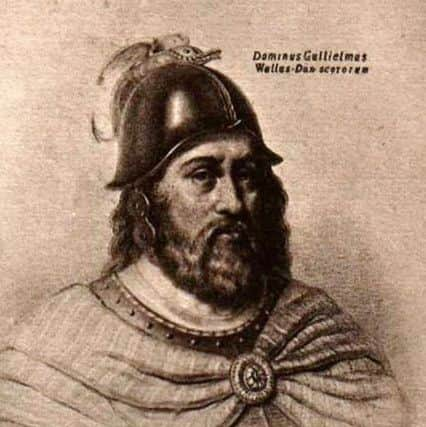William Wallace myths busted


Myth: Wallace’s father is Malcolm Wallace who is later killed along with young Wallace’s brother John, after which Wallace’s uncle Argyle adopts the young boy.
History: Wallace’s father’s name was Alan Wallace, not Malcolm, and he would not have been killed when Wallace was a boy. In fact he was likely alive when Wallace was fighting his rebellion. Wallace had a brother named Malcolm though, in addition to his brother John. His brother John Wallace was not killed when Wallace was a boy, but was executed by the English in 1306, a year after Wallace’s execution. Uncle Argyle was a fictional character, although an uncle or two may have indeed helped educate William as a boy.
Advertisement
Hide AdMyth: Wallace fell in love with a lady called Murron, and secretly weds her. He has no intention of fighting the English or freeing his country until she is killed. Wallace takes revenge on the Sheriff who cut her throat by cutting his.


History: Wallace may have indeed fallen in love with and married a young woman, although legend says her name was Marion Braidfute. After the supposed wife of Wallace was killed in Lanark, Wallace gathered a bunch of men and did indeed wreak havoc on Sheriff William Heselrig and his English guards. After advancing on the town, Wallace is said to have cut the Sheriff to pieces with his sword, and he and his band proceeded to burn two houses with the English guards inside. Wallace was already an outlaw against the English before his wife was killed. Wallace was opposed to English rule from the very beginning and refused to sign the Ragman Roll.
Myth: A number of places in Loudoun and Galston parishes are associated with William Wallace, but Blind Harry in his epic poem “The Wallace” tells the story of Wallace’s ambush of the English at Loudoun Hill. The poem also tells how somewhere within the parish a hospitable innkeeper supplied the party of Scots as they prepared to intercept a convoy on route westward to Ayr.
History: The actual battle site was probably at the eastern entrance to the narrow pass known as the Winny Wizzen, it’s strategic position at the head of the valley meant it was often passed by armies making their way inland or out to the coast.
Myth: Wallace is executed by being hung until semi conscious, stretched, then disembowelled and beheaded. His head is then sat on London Bridge and his arms and legs sent to Berwick, Newcastle upon Tyne, Stirling and Perth as a warning.


History: All true, except they left out the parts where Wallace was drawn behind horses for 5 miles or so, then hung, stretched, disembowelled, castrated, his heart, lungs and organs torn out and then finally beheaded and quartered.
Myth: Edward I dies as Wallace is being executed.
Advertisement
Hide AdHistory: Edward I died in 1307, two years after Wallace’s death, on his way north to once again deal with the ‘troublesome Scots’.
Myth: After the Battle of Stirling Bridge the Scottish Nobility name Wallace as Guardian of Scotland and grant him knighthood after which Wallace proceeds to invade Northern England.
Advertisement
Hide AdHistory: After the battle of Stirling Bridge, the Scottish Nobility named Wallace and Andrew de Moray Joint Guardians of Scotland. Andrew de Moray is not even mentioned in the film. The battle of Stirling Bridge without De Moray is as ludicrous as the battle of Stirling Bridge without a bridge! Wallace was not given knighthood until after his invasion of Northern England. During Wallace’s invasion, Andrew de Moray died from wounds sustained at Stirling. When Wallace returned he was made sole Guardian of Scotland.
Myth: We all know the story of Wallace’s betrayal by Monteith at Robroyston, and his subsequent removal to London to be executed for alleged treason in the most barbarous method possible.
He was sentenced to be hanged, drawn and quartered, a peculiarly English ritual which was supposed to ensure that the ‘guilty’ could not rise again on Judgement Day - vengeance even beyond the grave.
His head was spiked on London Bridge, and the four quarters of his mutilated body displayed in Newcastle, Berwick, Perth and Stirling, as a warning to all who transgressed against rule of Longshanks. And there his story ended – with no final resting place for Scotland’s best-known hero.
Or did it?
History: Cambuskenneth Abbey is, sadly, mostly ruined now, and apart from the main tower little remains bar foundations and low (ground level) walls. Local tradition however still marks the spot where it is said that Wallace’s remains were interred by the loyal monks. Walk past the tower to your left, and then east along the inches-high wall, itself running almost due east. A little way along, just to your right (the south of the wall) is a small stone embedded in the ground, perpendicular to the remains of the wall. It’s about 18 inches long and maybe six inches wide, orientated roughly north to south. At the southern end, faintly discernible although badly eroded, can still be made out the initials “WW” in antique script. A coincidence, you might think, or perhaps something placed later to give substance to the legend?
Stand at the southern end of the stone and look north along it. What do you see? The stone points straight towards the Abbey Craigs, the scene of Wallace’s greatest triumph. The massive rock on which he and De Moray stood to direct the course of the battle with their horns and trumpeters…
Advertisement
Hide AdSo is it true? No-one knows, but it’s a nice wee story. I personally would like to think that the good monks of Cambuskenneth did their Christian duty to the relative of a friend, and helped avert at least some of Longshanks’ malevolence. It’s worth a visit if you are in the vicinity. And funnily enough, you will often find on visiting that the stone has a small white rose placed on it. Some of us remember.
Gary Stewart is convenor of the Society of William Wallace.